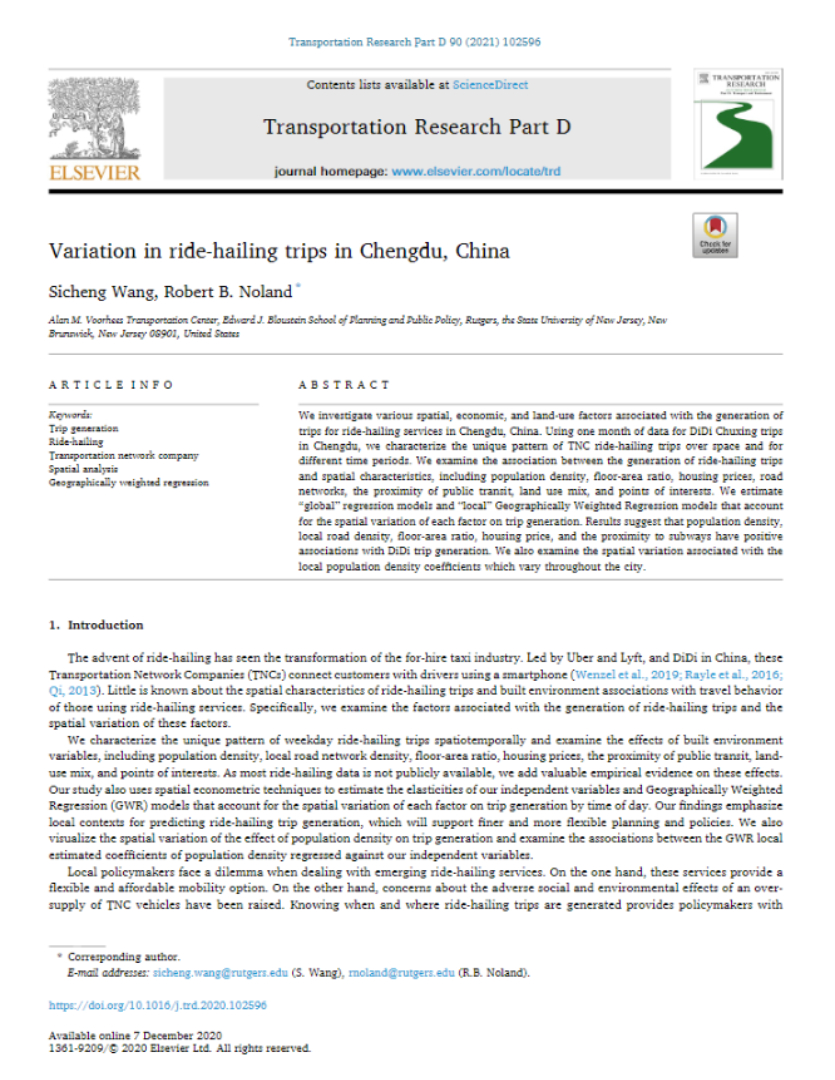Noland, R.B, Wang, S, (2021). Variation in ride-hailing trips in Chengdu, China. Science Direct. https://www.sciencedirect.com/science/article/pii/S1361920920307823?via%3Dihub
Abstract
A new paper by Bloustein School doctoral candidate Sicheng Wang and Distinguished Professor Robert B. Noland looks at the elasticities of demand for ride-hailing service provider DiDi in Chengdu, China.
Ride-hailing is frequently used for social, leisure, and recreational trips to destinations such as retail stores, restaurants, and sports and entertainment facilities. This is more likely in the evening when users are dropped off at these locations and then late at night they also return home.
In “Variation in ride-hailing trips in Chengdu, China” (Transportation Research Part D), the objective was to examine factors associated with the generation of ride-hailing trips. Associations were found with various built environment variables such as population density, local road network density, floor-area ratios, housing prices, the proximity of public transit, land use mix, and points of interest for various activities. Knowing when and where ride-hailing trips are generated provides policymakers with information on how to accommodate these mobility services within an intermodal urban transportation system.
Areas with a greater number of tall office towers or condos generate more ride-hailing trips than do older neighborhoods with relatively lower floor-area ratios (i.e., buildings that are not high-rise structures). The effect of population density is more significantly associated with trip destinations in the morning and trip origins in the evening and late at night. Housing prices have a positive association with both pick-ups and drop-offs in all models. Therefore, places with higher housing prices, which are correlated with household income and wealth, generate more ride-hailing trips. These results suggest that ride-hailing is more likely to service wealthier households.
Proximity to a subway entrance is also associated with ride-hailing trips, compared to other locations. This suggests that ride-hailing can serve as an access and egress mode to high-capacity transit services. Similar effects are also found for other transportation hubs, such as railway stations and intercity bus terminals. Transportation Network Companies in China may be able, therefore, to complement high-capacity public transit modes, enabling long-distance travelers to reach their final destination.
Understanding the pattern of ride-hailing trips may be particularly useful for locating specific pick-up and drop-off zones, to better manage curb-space and avoid blocking through traffic. There are policy implications related to the temporal variation found in associations with the built environment. For example, high-density areas and subway-adjacent neighborhoods may generate more demand during the morning peak hours; those areas with more restaurants may expect higher travel demand late at night. These temporal variations are likely related to different trip purposes, and these “hot spots” need time-varying management strategies. Incentives that promote ride-splitting trips (trips shared with other passengers who have similar routes) during times of high demand may reduce the congestion caused by ride-hailing. Identification of those areas and activities which attract ride-hailing trips can benefit planners seeking to provide more options for travelers.
